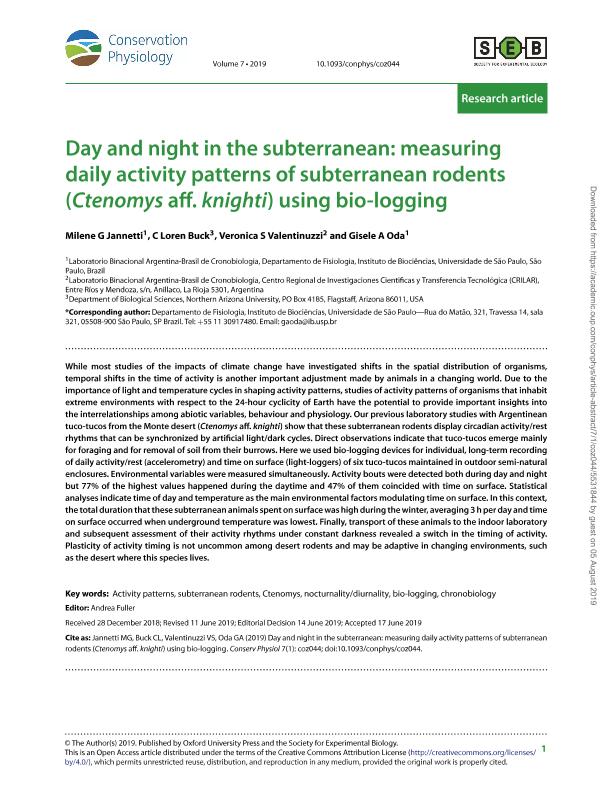Mostrar el registro sencillo del ítem
dc.contributor.author
Jannetti, Milene G.
dc.contributor.author
Buck, Charles Loren

dc.contributor.author
Valentinuzzi, Verónica Sandra

dc.contributor.author
Oda, Gisele Akemi

dc.date.available
2020-11-18T12:52:54Z
dc.date.issued
2019-09
dc.identifier.citation
Jannetti, Milene G.; Buck, Charles Loren; Valentinuzzi, Verónica Sandra; Oda, Gisele Akemi; Day and night in the subterranean: measuring daily activity patterns of subterranean rodents (Ctenomys aff. knighti) using bio-logging; Oxford University Press; Conservation Physiology; 7; 1; 9-2019; 1-13
dc.identifier.issn
1873-507X
dc.identifier.uri
http://hdl.handle.net/11336/118573
dc.description.abstract
While most studies of the impacts of climate change have investigated shifts in the spatial distribution of organisms, temporal shifts in the time of activity is another important adjustment made by animals in a changing world. Due to the importance of light and temperature cycles in shaping activity patterns, studies of activity patterns of organisms that inhabit extreme environments with respect to the 24-hour cyclicity of Earth have the potential to provide important insights into the interrelationships among abiotic variables, behaviour and physiology. Our previous laboratory studies with Argentinean tuco-tucos from the Monte desert (Ctenomys aff. knighti) show that these subterranean rodents display circadian activity/rest rhythms that can be synchronized by artificial light/dark cycles. Direct observations indicate that tuco-tucos emerge mainly for foraging and for removal of soil from their burrows. Here we used bio-logging devices for individual, long-term recording of daily activity/rest (accelerometry) and time on surface (light-loggers) of six tuco-tucos maintained in outdoor semi-natural enclosures. Environmental variables were measured simultaneously. Activity bouts were detected both during day and night but 77% of the highest values happened during the daytime and 47% of them coincided with time on surface. Statistical analyses indicate time of day and temperature as the main environmental factors modulating time on surface. In this context, the total duration that these subterranean animals spent on surface was high during the winter, averaging 3 h per day and time on surface occurred when underground temperature was lowest. Finally, transport of these animals to the indoor laboratory and subsequent assessment of their activity rhythms under constant darkness revealed a switch in the timing of activity. Plasticity of activity timing is not uncommon among desert rodents and may be adaptive in changing environments, such as the desert where this species lives.
dc.format
application/pdf
dc.language.iso
eng
dc.publisher
Oxford University Press

dc.rights
info:eu-repo/semantics/openAccess
dc.rights.uri
https://creativecommons.org/licenses/by-nc-sa/2.5/ar/
dc.subject
ACTIVITY PATTERNS
dc.subject
SUBTERRANEAN RODENTS
dc.subject
CTENOMYS
dc.subject
NOCTURNALITY/DIURNALITY
dc.subject
BIOLOGGING
dc.subject.classification
Biología

dc.subject.classification
Ciencias Biológicas

dc.subject.classification
CIENCIAS NATURALES Y EXACTAS

dc.title
Day and night in the subterranean: measuring daily activity patterns of subterranean rodents (Ctenomys aff. knighti) using bio-logging
dc.type
info:eu-repo/semantics/article
dc.type
info:ar-repo/semantics/artículo
dc.type
info:eu-repo/semantics/publishedVersion
dc.date.updated
2020-11-13T20:45:12Z
dc.journal.volume
7
dc.journal.number
1
dc.journal.pagination
1-13
dc.journal.pais
Reino Unido

dc.journal.ciudad
Oxford
dc.description.fil
Fil: Jannetti, Milene G.. Universidade de Sao Paulo. Departamento de Fisiología. Instituto de Biociencias; Brasil
dc.description.fil
Fil: Buck, Charles Loren. Northern Arizona University.; Estados Unidos
dc.description.fil
Fil: Valentinuzzi, Verónica Sandra. Consejo Nacional de Investigaciones Científicas y Técnicas. Centro Regional de Investigaciones Científicas y Transferencia Tecnológica de La Rioja. - Universidad Nacional de La Rioja. Centro Regional de Investigaciones Científicas y Transferencia Tecnológica de La Rioja. - Universidad Nacional de Catamarca. Centro Regional de Investigaciones Científicas y Transferencia Tecnológica de La Rioja. - Secretaría de Industria y Minería. Servicio Geológico Minero Argentino. Centro Regional de Investigaciones Científicas y Transferencia Tecnológica de La Rioja. - Provincia de La Rioja. Centro Regional de Investigaciones Científicas y Transferencia Tecnológica de La Rioja; Argentina
dc.description.fil
Fil: Oda, Gisele Akemi. Universidade de Sao Paulo. Departamento de Fisiología. Instituto de Biociencias; Brasil
dc.journal.title
Conservation Physiology
dc.relation.alternativeid
info:eu-repo/semantics/altIdentifier/doi/http://dx.doi.org/10.1093/conphys/coz044
dc.relation.alternativeid
info:eu-repo/semantics/altIdentifier/url/https://academic.oup.com/conphys/article/7/1/coz044/5531844
Archivos asociados
